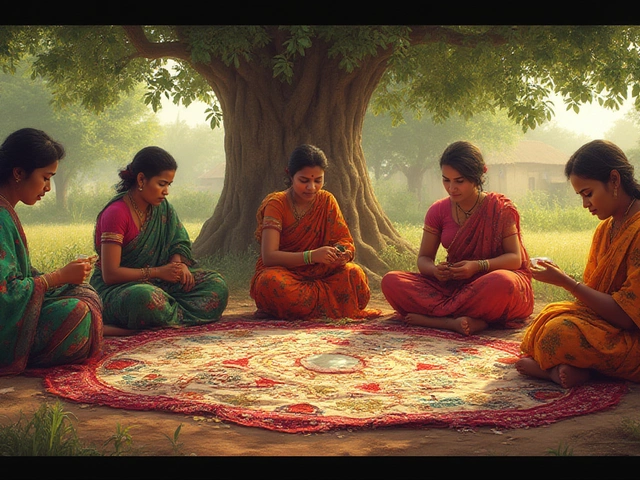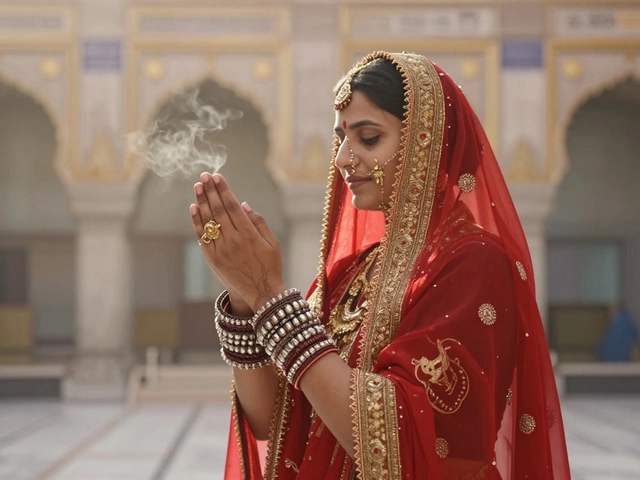When it comes to jewelry, India is a treasure trove, and among its many gems, temple jewellery stands out as something truly special. Originally crafted to adorn the deities in temples, these intricate pieces have a rich history that goes back centuries. Can you imagine jewelry so precious, it was meant for gods?
Let's dive into its unique designs and motifs. These pieces often feature depictions from Hindu mythology, such as gods and goddesses, peacocks, and other sacred symbols. They are crafted mostly in gold, sometimes adding gemstones to enhance their beauty. Each motif tells a story, connecting the wearer to a deeper spiritual journey.
- History and Origin
- Key Designs and Motifs
- Regional Variations
- Modern Usage and Fashion
- Tips for Buying and Care
History and Origin
Temple jewellery has roots that dig deep into the heart of Indian history. This kind of jewellery dates back to the Chola Dynasty around the 9th century. Can you picture how such ancient times have shaped what we see today in markets and fashion shows?
Originally, these jewels were meant to honor deities and adorn temple statues. Artisans crafted them using gold and selected gemstones to ensure they were suitable for gods. Over time, the beauty of these pieces captured the imaginations of kings and queens, and it wasn’t long before they transitioned from temples to palaces.
The motif-heavy designs borrowed heavily from Hindu mythology, featuring intricate carvings of gods, goddesses, animals like elephants, and symbols like the lotus. This imbued each piece with spiritual significance, a bit more than just your average accessory.
The Influence of Dynasties
Different regions and ruling dynasties added their flair. For example, the Cholas were known for their sophisticated designs, whereas the Vijayanagara Empire added a bolder, more elaborate style. This evolution is remarkable, showing how local cultures and beliefs can impact something as tangible as jewellery.
As time passed, temple jewellery became a staple in bridal wear and festive occasions. It’s interesting how every piece tells a different story, linking to who wore it and when. Textiles and even dance forms like Bharatanatyam have incorporated these traditional designs, enhancing their visual richness.
Key Designs and Motifs
The hallmark of Temple Jewellery lies in its intricate and symbolic designs. Each piece is more than just an accessory; it's a piece of art carrying centuries-old traditions and stories from India's rich spiritual past.
Gods and Goddesses
One of the most distinguishing features in temple jewellery is the depiction of Hindu deities. Whether it's Lord Krishna playing his flute, Goddess Lakshmi showering blessings, or Lord Ganesh signifying wisdom, each figure is meticulously carved to honor these divine symbols. Wearing such a piece often whispers tales of devotion and cultural pride.
Peacocks and Elephants
The peacock, synonymous with grace and beauty, is a recurring motif. The national bird of India, its elegant form is often stylized in earrings and necklaces. Similarly, the elephant represents strength and prosperity, adding a majestic flair to bangles and armbands.
Sacred Symbols
In addition to figures, you'll often find abstract motifs like the lotus flower, which signifies purity and divine beauty. These patterns are usually incorporated into larger designs or featured prominently in rings and pendants.
Craftsmanship Techniques
Interestingly, the techniques used in crafting these designs include repoussé and chasing. Artisans shape and hammer the metal from the reverse side to create raised designs in wearable pieces. This method not only enhances the depth and texture but also highlights the dazzling appeal of traditional jewellery.
Use of Gemstones
Besides gold, temple jewellery often includes gemstones like rubies and emeralds, adding a pop of color. These vibrant stones elevate the overall aesthetic, drawing eyes and interest wherever the jewellery goes.
This intricate craftsmanship and use of meaningful symbols make temple jewellery a staple that beautifully bridges the past with the present, resonating with those who value history as much as they do style.
Regional Variations
India's rich tapestry of cultures gives rise to diverse styles of Temple Jewellery. Each region boasts its own unique craftsmanship and design, making the jewelry distinct yet authentically Indian.
Southern Styles
In the South, particularly in Tamil Nadu and Andhra Pradesh, temple jewellery is often crafted in bold, striking forms. The pieces from these regions heavily incorporate motifs of deities and temple architecture. You might come across beautifully detailed kasu malai, a necklace made from gold coins with goddess engravings, which is a staple in Tamil weddings.
Western Influences
Not too far away, in the state of Maharashtra, you'll find a mix of influences. Here, the jewelry often combines the grandeur of Maratha warrior spirit and the delicacy of temple designs. The nath, a traditional nose ring, often features distinct colorful beads and stones along with gold.
Northern Styles
Moving to the North, although temple jewellery isn't as prominent, the intricate Meenakari work of Rajasthan bears some resemblance. This involves enameling the gold with vibrant colors to create eye-catching patterns. While not temple jewellery in the traditional sense, its craftsmanship shares similar roots.
Each piece, regardless of its origin, is not just a fashion statement. It’s a craft, a tradition, and a piece of history passed down through generations. Whether you're drawn to the styles of the south or the nuances of the west, there's something in India's temple jewellery for everyone.
Modern Usage and Fashion
So how does temple jewellery fit into today's world of fashion? It's fascinating to see how these traditional pieces have seamlessly transitioned from sacred spaces to everyday and even high-fashion settings. Today, you might spot them at a wedding, a film festival, or even on the runway. These pieces have a timeless charm that resonates with various style palettes.
One of the coolest things about temple jewellery is its versatility. It can easily be mixed and matched with both traditional Indian attire, like sarees and lehengas, and modern outfits, such as gowns and even casual western wear. They add a touch of elegance and heritage to any look, making them a favorite for those who love to blend trends with tradition.
Contemporary Designs and Trends
While the traditional motifs remain a strong influence, contemporary designers have started experimenting with these designs. You'll find temple-inspired pendants on sleek modern chains, minimalist earrings with age-old motifs, and bangles crafted with a fusion of traditional and modern aesthetics. This innovation keeps the art form alive and relevant to younger generations.
Celebrity Influence
Many celebrities have played a role in popularizing temple jewellery in modern fashion. Stars from Bollywood wear these pieces during festivals, weddings, and movies, making them a coveted addition to any wardrobe. Their endorsement brings temple jewellery into the spotlight, encouraging more people to appreciate and adopt this style.
Want to add some temple jewellery to your collection? Look for pieces that blend authenticity with modern design. Check local artisan markets or reputable jewellery stores. And remember, taking care of these pieces is essential—ensure they are properly cleaned and stored to maintain their luster over time.
Tips for Buying and Care
Getting your hands on authentic Temple Jewellery can be a bit of a task, but it's definitely worth the effort. These traditional pieces not only have spiritual significance but also pack a punch in terms of style and craftsmanship. So, how does one go about buying and caring for these gems?
Buying Authentic Temple Jewellery
- Research Trusted Sellers: Always buy from reputable sellers or dealers who specialize in Indian jewelry. Check reviews and ask for certifications if available.
- Check for Hallmarks: Genuine pieces, especially those made from gold, should have proper hallmarks. It's a surefire way to authenticate purity.
- Material and Craftsmanship: Temple jewellery often involves high craftsmanship. Look closely at the designs; they should be intricate and precise, often with traditional motifs like deities or peacocks.
- Understand Regional Styles: Different regions in India have their own unique styles. Knowing what you're looking at can help you appreciate the craftsmanship better and ensure what you're buying is authentic.
- Ask for a Certification: It's important, especially when investing in high-value items made of gold or gemstones. Authentic temple jewellery will usually have some form of certification or appraisal.
Caring for Your Jewellery
These pieces deserve some tender loving care to retain their shine and details. Here’s how you can manage that:
- Separate Storage: Store your jewelry in separate soft pouches or lined boxes to prevent scratches and tarnishing.
- Regular Cleaning: Clean them regularly with a soft cloth. Avoid using harsh chemicals; a gentle soap bath followed by an air-dry works best.
- Avoid Exposure: Keep them away from excessive moisture and direct exposure to perfumes or sprays which can damage the metal or stones.
- Periodic Checkup: Just like you take your car for maintenance, a regular checkup at a jeweler can ensure that stones are secure and there isn’t any unnoticed damage.
By following these tips, you ensure that your piece of temple jewellery not only stays stunning but also serves as a lasting heirloom, carrying forward the rich heritage of India.


